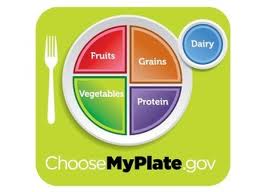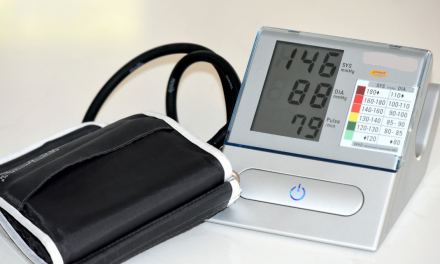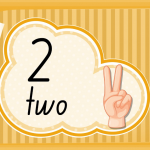Despite attempts to engender healthy eating strategies in North America with Canada’s Food Guide and the USDA MyPyramid, obesity rates are higher than ever before. On June 2nd, the United States introduced a revolution of sorts to their recommendations – they have thrown out their Food Pyramid and replaced it with a simple, effective strategy: a portion controlled plate!
USDA’s MyPlate is the most recent piece in the evolution of America’s dietary counseling history (a fascinating history, which you can read more about here). On the MyPlate plan, Americans are asked to portion our meal on our plate into four categories: vegetables, fruit, proteins, and grains. Aside the plate is a circle called ‘Dairy’, which is meant to represent a portion of dairy product with your meal, such as a glass of skim or 1% milk.
On the website, you can hover over and click on any part of the plate to read more about what each food group should entail.
Some of the guiding principles of the MyPlate system include:
- vegetables and fruits should take up half of your plate
- vegetables and fruit can be raw, cooked, frozen, or canned, but should not be in oil or with extra high calorie containing sauces
- at least half of the grains eaten in a day should be whole grains
- eat at least 8 ounces of cooked seafood per week (adults)
- enjoy your food, but eat less
- avoid oversized portions
- drink water instead of sugary drinks
The MyPlate website contains an absolute wealth of information, including interactive links where you can look up caloric information of your favorite foods with MyFood-a-pedia, find out how much you should eat of each food group in order to achieve your personal goal of weight loss, weight maintenance, or weight gain; and even get help in creating a personalized meal plan! I really encourage you to have a look around their website, as there are all kinds of fascinating nooks and crannies of extra reading, and lots of user-friendly downloadable one-page summaries of healthy eating hints that are designed to post right on your fridge.
I’ve long been a big believer in the power of portion control. In my own research, we’ve shown that a simple portion control tool is useful even to help insulin using type 2 diabetics lose weight – a group in whom it is particularly challenging to achieve weight loss, as insulin is a hormone that can directly lead to weight gain.
I really take my hat off to the United States for taking this extremely user friendly and pragmatic approach to health eating in America. Though there are some elements that I would change (for example, I would not recommend dried fruit as it is much more calorie dense than fresh fruit), overall, it is an excellent, practical approach that everyone can access (online or in paper form). While this plate approach is only a small step forward, and does not address the plethora of contributors to obesity in our society, our sedentary lifestyles, or the psychological contributors to obesity, in my opinion it is a great way to help people formulate their eating patterns into a healthier approach on a daily basis.
As it currently stands, the Canada Food Guide remains our only standardized tool to guide healthy eating in Canada. We are in desperate need of a more practical approach, as the guide can be confusing to follow, can lead to weight gain amongst older adults, and offers no suggestions for modification for people who need to lose weight (making our Food Guide applicable to only a minority of the population, given that 59% of Canadian adults are overweight). We need to move forward as a nation and follow the good example that the United States has set with the MyPlate program.
Dr. Sue © 2011 www.drsue.ca drsuetalks@gmail.com
Follow me on Twitter for more tips! drsuepedersen
Follow me on Facebook: drsue.ca












